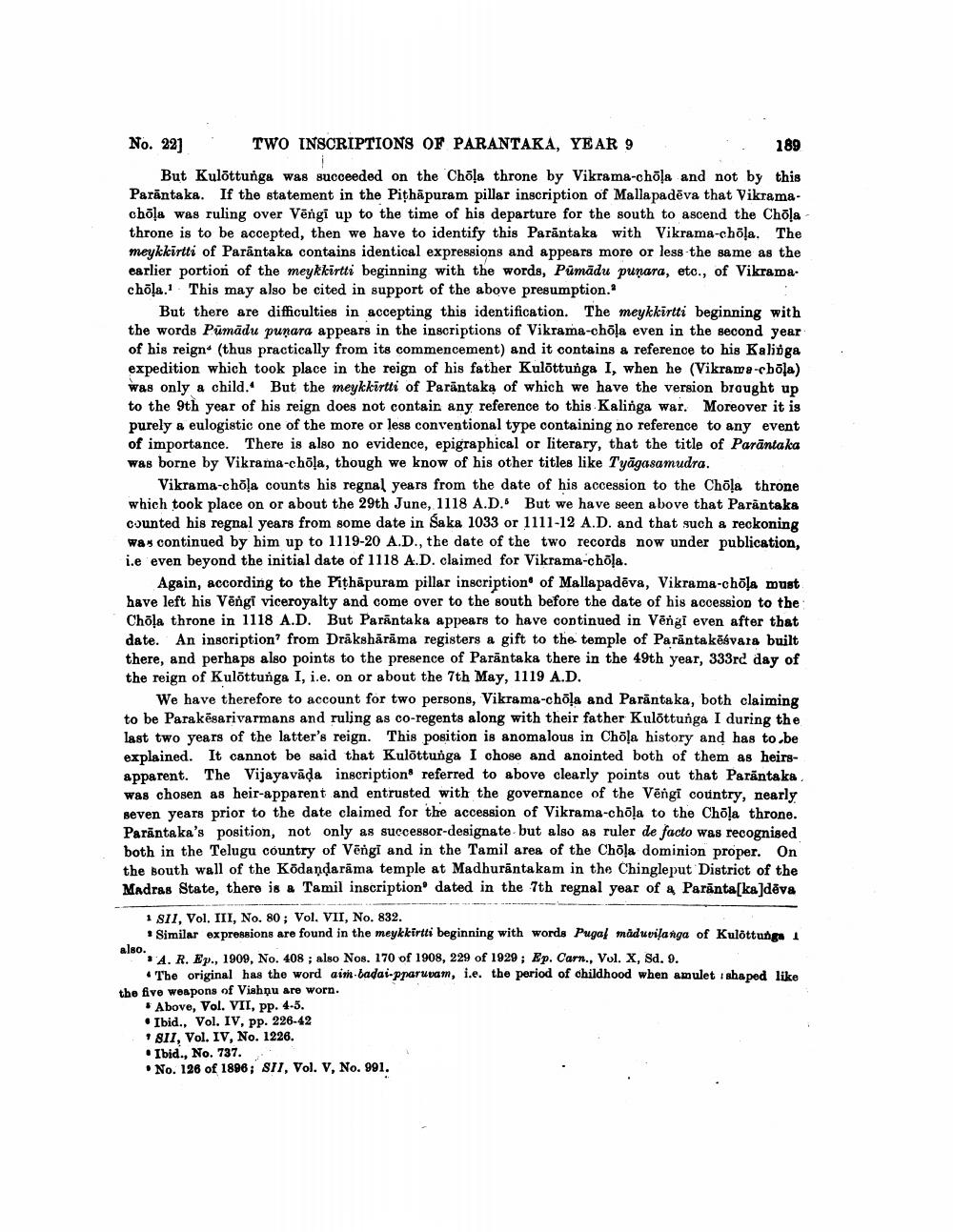________________
189
No. 22]
TWO INSCRIPTIONS OF PARANTAKA, YEAR 9
But Kulottunga was succeeded on the Chōla throne by Vikrama-chōla and not by this Parantaka. If the statement in the Pithapuram pillar inscription of Mallapadeva that Vikramachōla was ruling over Vengi up to the time of his departure for the south to ascend the Chōla throne is to be accepted, then we have to identify this Parantaka with Vikrama-chōla. The meykkirtti of Parantaka contains identical expressions and appears more or less the same as the earlier portion of the meykkirtti beginning with the words, Pumādu punara, etc., of Vikrama. chōla. This may also be cited in support of the above presumption."
But there are difficulties in accepting this identification. The meykkirtti beginning with the words Pūmādu puṇara appears in the inscriptions of Vikrama-chōla even in the second year of his reign (thus practically from its commencement) and it contains a reference to his Kalinga expedition which took place in the reign of his father Kulottunga I, when he (Vikrame-chōļa) was only a child. But the meykkirtti of Parantaka of which we have the version brought up to the 9th year of his reign does not contain any reference to this Kalinga war. Moreover it is purely a eulogistic one of the more or less conventional type containing no reference to any event of importance. There is also no evidence, epigraphical or literary, that the title of Parantaka was borne by Vikrama-chōla, though we know of his other titles like Tyāgasamudra.
Vikrama-chōla counts his regnal years from the date of his accession to the Chōla throne which took place on or about the 29th June, 1118 A.D. But we have seen above that Parantaka counted his regnal years from some date in Saka 1033 or 1111-12 A.D. and that such a reckoning was continued by him up to 1119-20 A.D., the date of the two records now under publication, i.e even beyond the initial date of 1118 A.D. claimed for Vikrama-chōla.
Again, according to the Pithapuram pillar inscription of Mallapadeva, Vikrama-chōla must have left his Vengi viceroyalty and come over to the south before the date of his accession to the Chōla throne in 1118 A.D. But Parantaka appears to have continued in Vengi even after that date. An inscription' from Drakshārāma registers a gift to the temple of Parantakesvara built there, and perhaps also points to the presence of Parantaka there in the 49th year, 333rd day of the reign of Kulottunga I, i.e. on or about the 7th May, 1119 A.D.
We have therefore to account for two persons, Vikrama-chōla and Parantaka, both claiming to be Parakesarivarmans and ruling as co-regents along with their father Kulottunga I during the last two years of the latter's reign. This position is anomalous in Chōla history and has to be explained. It cannot be said that Kulottunga I chose and anointed both of them as heirsapparent. The Vijayavaḍa inscription referred to above clearly points out that Parantaka was chosen as heir-apparent and entrusted with the governance of the Vengi country, nearly seven years prior to the date claimed for the accession of Vikrama-chōla to the Chōla throne. Parantaka's position, not only as successor-designate but also as ruler de facto was recognised both in the Telugu country of Vengi and in the Tamil area of the Chōla dominion proper. On the south wall of the Kodandarama temple at Madhurantakam in the Chingleput District of the Madras State, there is a Tamil inscription dated in the 7th regnal year of a Paranta[ka]dēva
1 SII, Vol. III, No. 80; Vol. VII, No. 832.
Similar expressions are found in the meykkirtti beginning with words Pugal măduvilanga of Kulottunga 1
also.
A. R. Ep., 1909, No. 408; also Nos. 170 of 1908, 229 of 1929; Ep. Carn., Vol. X, Sd. 9.
The original has the word aim badai-pparuvam, i.e. the period of childhood when amulet shaped like the five weapons of Vishnu are worn.
Above, Vol. VII, pp. 4-5.
Ibid., Vol. IV, pp. 226-42
8II, Vol. IV, No. 1226.
Ibid., No. 737.
No. 126 of 1896; SII, Vol. V, No. 991.




